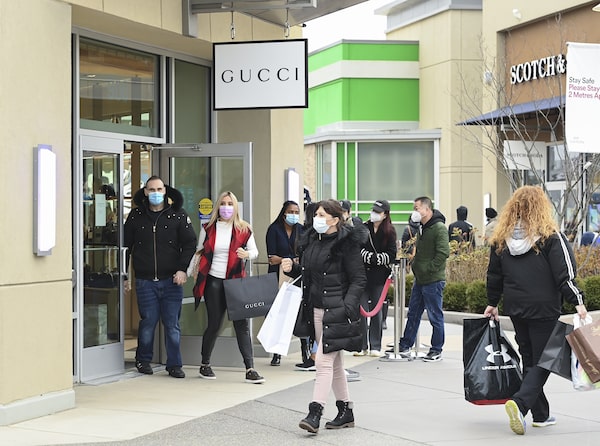
People line up at the Toronto Premium Outlets mall on Black Friday for shopping sales during the COVID-19 pandemic in Milton, Ont., on Nov. 27, 2020.Nathan Denette/The Canadian Press
Tu Nguyen is an economist and environmental, social and governance director with RSM Canada, based in Toronto.
Faced with soaring inflation and one of the steepest interest rate hike cycles in history, Canadian households and businesses have been bracing for the recessionary shoe to drop for the past year and a half. That’s why it will come as a surprise to many that a recession might not happen after all.
Despite wavering consumer sentiment and some initial bleak economic projections, the economy has continued to soldier on. Canada has added a whopping 284,000 jobs this year. Consumer spending on services has been robust. Real estate activity has picked up after a brief slump. The economy has proven remarkably resilient while facing the dual challenges of high interest rates and high inflation.
Now, Canada could very well be heading to the rarely achieved goal of a soft landing, or a slowdown without a recession.
Already, data are showing that Canada will avoid a recession this year altogether, a stunning development that few would have believed when the Bank of Canada began raising interest rates last year. The probability of a recession over the next 12 months now stands at 60 per cent, according to our forecast at RSM Canada. That’s not much more than a coin flip, and is down from 75 per cent earlier this year. Moreover, that probability could decline further in the days ahead.
If anything, Canada, after three years of whipsaw change in the economy, is on a path to steady, if slower, growth. Gross domestic product is expected to grow every quarter to a total of 1.7 per cent this year and 1.4 per cent next year, according to the International Monetary Fund.
Achieving a soft landing is easier said than done. Raising interest rates often precedes recessions by tightening financial conditions, which reduces borrowing and consumption.
But there is ample evidence that this time might be different. The economy has slowed just the right amount.
Inflation has dropped to around 3 per cent from the height of 8 per cent from just a year ago. Even core inflation measures, which exclude more volatile components such as food and energy and have proven sticky, are set to decline. And while the return to the Bank of Canada’s target inflation rate of 2 per cent will take time, the data are trending in the right direction.
Demand for labour is showing signs of moderating, just like the Bank of Canada would like to see. Unemployment inched up to 5.5 per cent in July, but most employers, concerned about finding new workers when the economy eventually picks up, are retaining their workers. This means that households will be able to hold on to their paycheques and keep spending, albeit more slowly as their savings built up during the pandemic dwindle.
These factors (falling inflation, cooling labour demand and slowing growth), while a drag on the economy, might be enough for the Bank of Canada to hold its policy rate at 5 per cent, thus averting a far greater drag. Without another rate hike, the economy could have enough steam to push through until the first rate cut, most likely in April, 2024, without falling into a recession.
One lifeline to the economy has been immigration. As hundreds of thousands of people come to Canada every year – 405,000 last year, 465,000 this year and a projected 500,000 in 2025, according to Immigration, Refugees and Citizenship Canada – immigration not only adds to the labour supply but also boosts consumer demand.
Many newcomers are in their prime working years, which rejuvenates Canada’s aging work force and fills gaps in industries with worker shortages. In addition, immigration supports demand for all types of goods and services, from housing to consumer products to education.
In addition, Canada might skirt a full-blown recession and instead only face a “rolling recession” where industries contract at different times while the overall economy stays afloat. In a way, this is already happening: Manufacturing is recovering after last year’s supply chain struggles; real estate seems to have stabilized; and technology has been going through select layoffs. Yet service industries are still going strong.
Though current GDP figures show a slowdown, they are largely driven by temporary shocks such as worker strikes and wildfires. A look beyond these shocks reveals the underlying strength of the economy.
A soft landing is not a guarantee. Some slowdown is certain. The impact of the central bank’s rate hikes will not be fully absorbed until next year. An external shock, such as a climate or geopolitical one, could push the economy into a recession.
But with cooling inflation, solid consumer demand fuelled by population growth, and an absence of shocks, Canada might just make it. By next year, as the Bank of Canada begins slashing rates, growth will be on the horizon again, and this period may be remembered as the moment we achieved that elusive soft landing.